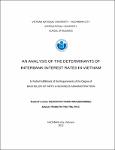| dc.description.abstract | This thesis provided an outlook of the monetary policy and the interbank market in Vietnam, and then it analyzed the determinants of interbank interest rate. According to the theory, there are five determinants of interbank interest rate: deposit rate, lending rate, discount rate, refinancing rate, requirement reserve ratio, and Open Market Operation. The data used for the analysis of the effects of these factors on the interbank rate were collected from the State Bank of Vietnam and the International Monetary Fund from 2007 to April 2011. This thesis used both the descriptive and quantitative research. The descriptive research was used to have an overview of monetary policy and the interbank market in Vietnam; the quantitative method was used to analyze
the determinants of interbank interest rate. The regression and correlation analysis were applied for this method. Firstly, in comparison with the monetary policy in developed countries, Vietnamese monetary policy has some differences. The most important difference between them is in the role of interbank interest rate in the conducting of monetary policy. Secondly, the interbank market has played the more important role in Vietnamese financial system. When commercial banks faced to the difficulty of liquidity, they usually borrow on the interbank market rather than other channels. Finally, the refinancing rate was eliminated in the regression model to prevent the multicollinearity which may affect the reliability of the regression analysis as it has a high correlation with discount rate. In general, except Open Market Operation, the lending rate, deposit rate, discount rate, and requirement reserve ratio have the positive relationship with the interbank rate. Among them, the discount rate and deposit rate have the strongest relationship with interbank interest rate. Therefore, they need more focus in the process
of anticipating the changing of interbank interest rate in Vietnam. | en_US |


